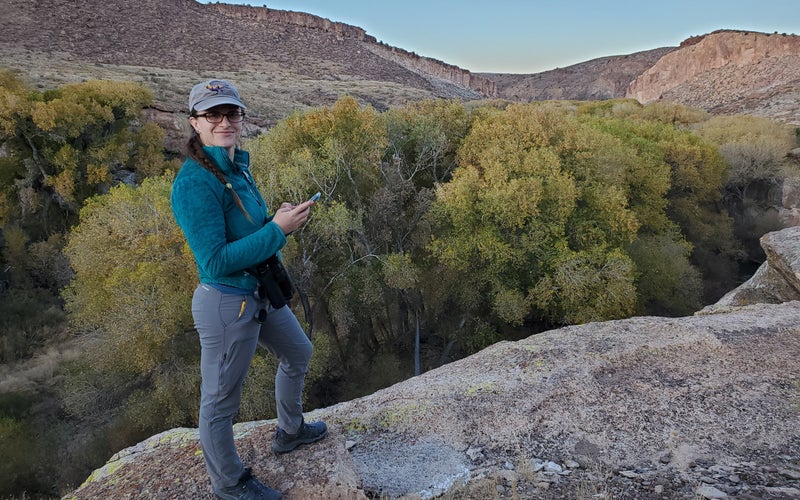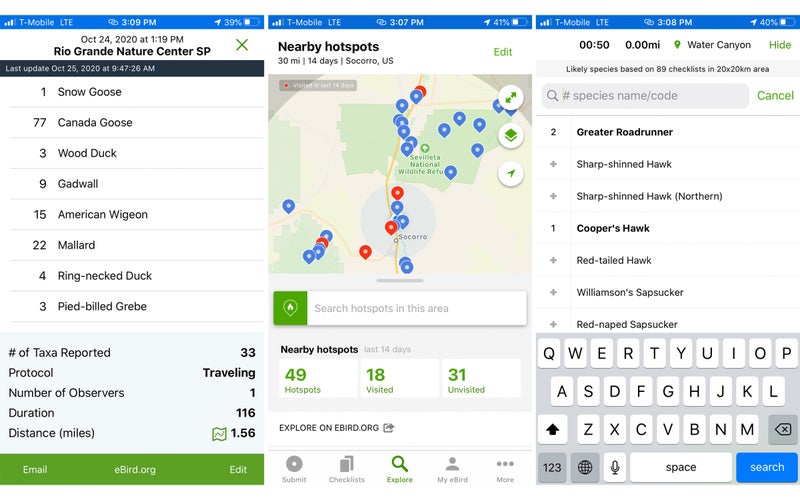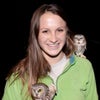In July 1992, two Danish birders visiting Patagonia, Arizona reported the first-ever, mega-rare in the United States. Back then, reporting rare birds required phoning in observations to a “rare bird phone tree,” usually via the nearest pay phone—and hoping that word got out. Sometimes it did, sometimes it didn’t. In this case, a couple of other out-of-towners—a birder from Mississippi and another from Nebraska—saw the species. The Nebraskan photographed the hummingbird, flew home, developed the slide film, and snail-mailed photos to the Arizona committee in charge of validating unusual sightings. Only then did word spread, but it was too late: the hummingbird was gone, and Arizona birders missed it.
This kind of tragedy would never befall Arizona birders today. Now, within minutes of seeing a rarity, birders can text friends, alert listservs, post sightings to Facebook rare-birds groups, and—the choice of many—submit observations to , a global online database.
At its most basic level, eBird documents bird sightings. A team at the created the platform in 2002, and it became widely used by birders within a few years. As of 2020, it has collected more than 860 million global bird observations from over 597,000 registered eBirders. By sheer numbers alone, eBird is one of the world’s largest citizen-science projects. It is now used to understand species distributions, population trends, migration pathways, and even habitat use.
“If used properly, it should be a tool to understand bird populations at scale in ways we never have before, and to apply that to conservation actions,” Marshall Iliff, an eBird project leader, told me. Scientists use eBird’s open-access data to study ���Ի��� ���Ի���to highlight the . The eBird team has also created conservation-oriented for hundreds of species, and eBird data are used to create .

At least 120 million observations are submitted per year, many through the handy eBird app, a kind of Strava-Yelp-Pokémon Go hybrid for birders. The app doesn’t ID birds for you—Cornell offers for that—but instead provides an easy way to record and upload the birds you spot. To log sightings, you start a checklist (similar to the way you’d start a run on a smartwatch) and the app automatically pulls your location via GPS. You can choose hot spots near you, which generate lists of species you’re likely to see created from data submitted by users in those areas. The app tracks time and distance traveled while you “tick” species and numbers of birds seen and heard. It even lets you keep an offline checklist, so you aren’t inconvenienced without cell service. On the web platform, users can upload photos and audio recordings to beef up checklist documentation. Once submitted, the observations join on the platform at any given time.
The scope and accessibility of eBird make it a resource for birders and scientists alike. The majority of eBirders use the platform as a handy bird-logging tool. I study birds for my Ph.D. at the University of New Mexico, and I also watch them recreationally. I use eBird almost daily for everything from tracking how far I walk while scanning treetops, to planning vacation birding spots, to scouting remote Andean field sites for my doctoral work. Anyone can review lists of species in hot spots like stretching back decades, study maps of where birds are seen, analyze how frequently certain birds appear at different times of the year, and peruse photos and audio recordings from all over the globe.
Undeniably, eBird has changed birding culture, a quirky world already full of strong opinions. It brings birders together and allows for rapid information sharing. It’s also created new—and sometimes contentious—etiquette and social dynamics.
The closest thing to an official guide for birding etiquette is the American Birding Association’s , which emphasizes a few basic tenets that can be summarized as: Respect fellow birders, their diverse interests, and skill levels. Welcome and encourage beginners. Respect birds and other wildlife. Don’t trespass on private or restricted property. Be mindful of space and privacy when birding in groups. (Since the pandemic, a new set of guidelines on birding and social distancing has been added to the code, titled )
Birders are typically friendly, both in person and online, with email exchanges often ending in well-wishes of “Good birding!” But a code of ethics is necessary because, as with any activity that can become competitive, birding has a dark side. Rivalry, animosity, and ego have long been hallmarks of the bird world. Even the famous naturalist John James Audubon to convince members of the English nobility to promote his work. Birders sometimes go to semi-desperate lengths to track down birds, and online platforms like eBird that rank birders and sightings, akin to athletes on leaderboards, can amplify competition.
Although eBird is primarily an observation tool and a scientific database, the site still allows users to size each other up: anyone can view rankings of the top eBirders in different hot spots, counties, states, and entire countries. You can even peruse a list of the . These types of competitive lists have birthed trends like , in which birders constantly compete to see who can spot the most species in a year. In turn, such fads have spurred counterinitiatives, like the , which encourages birders to enjoy birds in local areas rather than seeking them out in far-flung places. Local birding has , as many work from home and explore their own backyards.

If an eBird user makes their profile public, other eBirders can view their recently submitted checklists and photos. Essentially, this means that birders can keep tabs on one another. Last October, when a friend was in Belize, I lived vicariously through his trip by peeking at his eBird checklists each day, and they brightened my mood amid dropping fall temperatures in New Mexico. I’ve also received unexpected text or Facebook messages from birders with quips like, “Looks like you had an awesome day!” after they saw checklists I submitted. These interactions shouldn’t be surprising, given the public nature of eBird data, but it occasionally strikes me as odd that people I don’t know well can see exactly where I walked for eight hours and exactly how many Wilson’s warblers I counted while I did so.
The eBird database also maintains a frequently updated alerts bulletin called the . The RBA, as many lovingly call it, pushes notifications to users so they can quickly find out who’s seeing what and where. The excitement of rare, sought-after species fuels cultures of chasing and listing that emphasize the prestige of finding rare birds and seeing more species than others.
Chasing rarities is certainly exciting—like an ephemeral, high-stakes treasure hunt where the pot of gold has wings—but the hobby can also turn into an obsession. I’ve heard stories of constant “twitching,” or compulsive bird chasing, nearly ending serious romantic relationships. For some, a reputation for finding rare birds becomes a noteworthy part of their identity. Last fall I met a birder at a , a small patch of trees with a trickle of water, on the windswept plains of eastern New Mexico. He introduced himself to me by name, followed by, “You might recognize me from the Rare Bird Alert.”
A thirst for finding rarities can also encourage behavior that goes against common courtesy. One eBird app reviewer, “Notta Realname,” noted that after spotting an unusual bird for their locality, birders rang their doorbell, asking to sit in their backyard so they could see the bird. Notta Realname reported being “flummoxed” but welcomed the birders into their backyard anyway and then became frustrated when the unexpected guests displayed “questionable” ethics. Notta Realname turned away subsequent birders and then changed their privacy settings. All birders I know would agree: showing up at a stranger’s doorstep unannounced is bad form.
Because eBird is not a social-media site—there is no way to follow friends or comment on sightings—these types of interactions filter onto other platforms. Last fall an 11-year-old friend and beginning birder ticked the wrong species of quail on her checklist, which made it look like a bird from Africa and the Arabian Peninsula had been sighted in central New Mexico. Rather than wait for eBirders to flag the mistake respectfully, someone made fun of her in a Facebook birding group.
Occasionally, eBird itself is the site of bad behavior. Recently, a respected birder misidentified a common lazuli bunting for a more unusual species: a dickcissel, or “DICK” in , a sparrowlike bird of open grasslands easily recognized by its “flatulent buzz” calls. Several experienced birders tried correcting his mistake, but he stubbornly refused to change his ID, insisting the bird was simply “odd-looking.”
As with any activity that can become competitive, birding has a dark side.
I had my own run-in with bad behavior on eBird last November. I’d gotten wind via the eBird Rare Bird Alert that a vagrant woodcock had been spotted along the Rio Grande near Albuquerque, New Mexico, just 15 minutes from my house. American woodcocks are iconic little solitary shorebirds that live in forests and , and they’re rarely seen out west. Naturally, I had to chase this bird. At 7 A.M. on a Sunday, I found myself walking along the river, kicking up piles of dead leaves in an attempt to flush the woodcock.
After a few hours, I’d had no luck. As I headed back to my car, I passed a group of birders also searching for the woodcock. We chatted for a bit before a well-known birder—the one who misidentified the DICK—recognized me. With a facetious smile, he asked, “How’s your goose ID going?”
The other birders stared blankly while I brimmed with silent shock and anger. He was publicly mocking me—a week before, he’d emailed me about a misidentified Ross’s goose I posted on eBird. Embarrassed, I quickly updated my observation. Our interaction should have ended there, but instead he was now calling me out for my mistake—gleefully—in front of others.
“Fine,” I said curtly, before walking back to my car.
When I got home, I ranted to my significant other, who is used to hearing too much about birds. He thought I sounded more wound up than usual—eBird can sometimes do that to you.
In recent years, eBird has grown tremendously. Between 2019 and 2020 alone, observations submitted to the database increased by 24 percent. Some believe that the rise in new eBird users is associated with a dangerous level of data imprecision. Can the data be trustworthy if they come from millions of observers who might not be able to correctly identify common backyard birds? As one well-known California birder has been known to say, “The average birder is below average.”
This is where data-vetting steps, like, come in. Each eBird reviewer is a volunteer selected for their knowledge or experience in a state, region, or country. Reviewers act as quality filters and check observations for accuracy, detail, and validity. They may contact observers to request specific details about unusual sightings, point out misidentifications, or ask for justification about higher-than-expected numbers reported for a particular species. Some reviewers even go out of their way to coach users unfamiliar with eBird on how to use the database and app to enhance the quality of the information. This verification effort, in turn, makes eBird data more valuable to birders, citizen scientists, and professional scientists.
“My goal when reviewing is to make sure that an observation is documented well enough so that, in 100 years, someone who doesn’t know who the observer is can say, ‘This is reasonable,’” says Lauren Harter, an eBird reviewer of more than nine years for the Colorado River area.
Given their status, reviewers are privy to moments of birding vulnerability, such as when birders make identification mistakes. Errors are expected—even the world’s best can confuse extremely similar-looking or . If an eBird reviewer catches an ID mistake, usually from a photo, they reach out to the eBird user, typically with a polite template email that starts with, “Thank you for being a part of eBird. To help make sure that eBird can be used for scientific research and conservation, volunteers like me follow up on unusual sightings as a part of the eBird data quality process.” They’ll then explain why the species is listed incorrectly and request that the user change the ID to the correct species.
Given their status, reviewers are privy to moments of birding vulnerability.
This mutual respect between reviewers and birders tracks with offline birding etiquette, but sometimes interactions can turn to rudeness. The birder who made fun of me for my goose mistake, for example, was a New Mexico eBird reviewer, and one birder friend, after hearing the story, called the reviewer’s comment to me “way out of line.”
The relationship between reviewers and observers can be tricky to navigate. Reviewers sometimes screen as many as several hundred sightings per month, and they certainly deal with their fair share of user mistakes. I became increasingly respectful of the work they do as I spoke to more reviewers for this story. But some believe that reviewers exercise their power unfairly—for example, by accepting rare sightings by birders with good reputations, even with scarce documentation—and impose personal rules about how birding should be done in “their” territory.
This culture of the right and wrong way to do things can apply to the eBird world at large. Last year a friend birded at a popular eBird hot spot outside Raleigh, North Carolina, during a work trip. After submitting his checklist, he was contacted by a local eBirder who, in typical birder fashion, sent him overly detailed instructions about how to walk around the lake. My friend, a birder of 34 years, felt like his freedom to explore had been violated. There was a right and wrong way to walk around a lake now? “I was bemused that someone would want to exert control over how others experience a place,” he told me. “The idea that a hot spot has to be birded in a certain way and recorded in a certain way really takes the enjoyment out of visiting new places.”
Despite the fact that eBird has become an almost unstoppable force, some birders have resisted the eBird tide. They see the platform—and the “Cornell mafia,” as one birder put it—as supplanting traditional methods of birding that many still prefer. Observers who don’t use eBird still rely heavily on listservs or Facebook birding groups, but this can limit access to information.
“It makes you almost have to be an eBirder to keep track of this stuff anymore,” says Gary Rosenberg, a professional bird-watching guide of more than 35 years. “I call it eBorg,” he says, referencing the Star Trek character who transforms people into drones through assimilation. “If you’re not on eBird, you’re currently just sort of left out in the cold.”
On the flip side, eBird has encouraged people who may not have birded previously to contribute sightings in a popular forum. This citizen-science participation aspect of the platform, coupled with movements like , are important for creating a diverse and equitable outdoors community. Increased representation and environmental awareness are sorely needed, given . “Anything we can do to supercharge an interest in nature is a worthwhile goal unto itself,” says eBird’s Iliff. “I don’t think we’re going to have people who are willing to vote for climate change or preservation of public lands or endangered species, or really care about the world around us, without a level of public engagement.”
For all its unexpected dynamics, eBird has succeeded in connecting birders and scientists in ways that weren’t possible before. Last fall, while browsing through images of the species I study for my Ph.D., the , I came across a photo of a bird that appeared to be wearing one of the to research their migration. The eBirder who posted the photo listed his email address publicly, so I reached out to see if he had others. He was friendly, ���Ի���he happily sent more my way. I flipped through them that night, amazed that a stranger’s photos might have unintended value for my research, and I wondered what other gems remained to be discovered on eBird.
